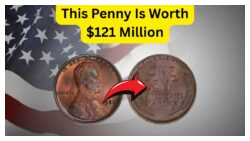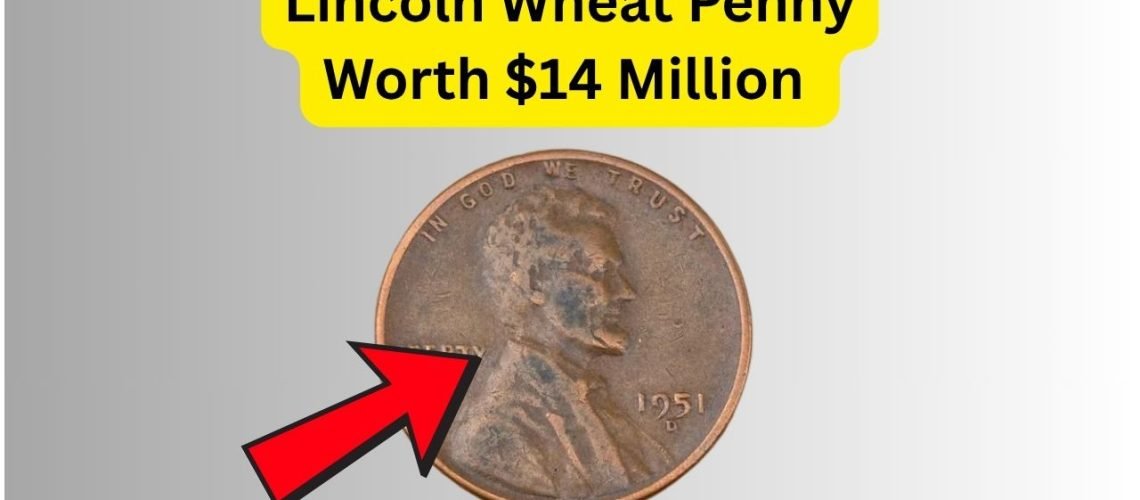Lincoln Wheat Penny Worth Millions: The Lincoln Wheat Penny, minted from 1909 to 1958, is a coin that has captured the imagination of collectors and numismatists alike. While most are worth just a few cents, there are rare versions that can fetch staggering sums at auction. Could one of these valuable coins be hiding in your pocket change? The most famous of these is the 1943 copper-alloy cent, which was mistakenly made with the wrong metal during World War II. This particular penny is rumored to be worth up to $14 million, turning a humble coin into a sought-after treasure.
Table of Contents
Toggle
History of the Lincoln Wheat Penny
The Lincoln Wheat Penny was first introduced in 1909 to commemorate the 100th anniversary of Abraham Lincoln’s birth. It marked a significant departure from previous U.S. coinage, being the first widely circulated coin to feature a real person’s likeness. Designed by Victor David Brenner, the penny featured Lincoln on the obverse and two wheat stalks on the reverse. The initial release was met with public enthusiasm, and its design has since become iconic. Over the years, changes in metal composition and minting locations have led to various anomalies, some of which are incredibly rare and valuable.
- The initial penny was made of 95% copper.
- During World War II, a zinc-coated steel version was produced.
- 1943 copper pennies are among the rarest.
- Design changes occurred in 1959, ending the wheat motif.
- Errors and mint marks contribute to rarity.
- Proof coins were minted for collectors.
- Millions were produced annually, but only a few are valuable.
Identifying Rare Lincoln Pennies
Identifying the rare Lincoln Wheat Penny variants is crucial for collectors and treasure hunters. The most sought-after is the 1943 copper penny, which should have been struck in steel due to wartime scarcity of copper. If you happen to find one, you could be sitting on a small fortune. Other valuable variants include the 1922 “plain” penny with no mint mark and the 1955 double die penny, which features a doubled image of the date. Knowing what to look for and understanding mint marks are key to identifying these rare coins.
| Year | Mint Mark | Metal | Rarity |
|---|---|---|---|
| 1909 | S | Copper | High |
| 1943 | D | Copper | Highest |
| 1955 | None | Copper | Medium |
| 1922 | Plain | Copper | High |
| 1914 | D | Copper | High |
| 1931 | S | Copper | Medium |
| 1909 | VDB | Copper | Medium |
Factors Influencing Value
The value of a Lincoln Wheat Penny is influenced by several factors. Condition is paramount; coins in mint state or with minimal wear fetch higher prices. Rarity is another critical factor—coins with low mintage numbers or unique errors are more valuable. The presence of a mint mark also plays a role, with certain mint locations producing fewer coins. Additionally, historical significance and collector demand can drive prices higher. Understanding these factors can help you assess whether your penny is a common find or a hidden treasure.

Discover the Lincoln Wheat Penny Worth $305K Still Circulating Today
- Condition: Mint state coins are most valuable.
- Rarity: Low mintage increases worth.
- Mint Mark: Certain mints are rarer.
- Error: Unique errors can skyrocket value.
- Historical Significance: Adds to collector appeal.
- Collector Demand: Fluctuates with trends.
Where to Find Lincoln Wheat Pennies
Finding Lincoln Wheat Pennies can be a rewarding pursuit for hobbyists and serious collectors. Start by checking your pocket change or old coin jars. Local banks often have coin rolls that might contain hidden gems. Flea markets, estate sales, and antique stores are excellent places to scour for these coins. Online marketplaces and auctions are also viable options, though they require careful scrutiny to avoid counterfeits. Networking with fellow collectors and joining numismatic clubs can provide leads and valuable insights into where to find these elusive pennies.
| Source | Pros | Cons | Tips |
|---|---|---|---|
| Pocket Change | Free, convenient | Rare finds | Check regularly |
| Banks | Inexpensive rolls | Limited rarity | Request specific years |
| Flea Markets | Unique finds | Varying quality | Inspect carefully |
| Online Auctions | Wide selection | Risk of fakes | Verify sellers |
Appraising Your Coins
Appraising your Lincoln Wheat Pennies is an essential step in determining their true value. Professional coin appraisers or numismatic experts can provide detailed evaluations based on the coin’s condition, rarity, and market demand. Online resources and price guides offer a starting point, but nothing beats a hands-on appraisal for accuracy. Be wary of appraisers who offer to buy your coins immediately, as their interest may conflict with providing an unbiased valuation. It’s also a good idea to get multiple appraisals to ensure you have a comprehensive understanding of your coin’s worth.
- Seek professional appraisers.
- Use online price guides.
- Get multiple opinions.
- Avoid on-the-spot offers.
- Consider auction house evaluations.
- Document your coins’ condition.
- Research comparable sales.
Protecting Your Investment
Once you’ve identified and appraised your valuable Lincoln Wheat Pennies, protecting your investment is crucial. Store coins in a controlled environment, away from humidity and temperature fluctuations. Use acid-free holders or albums to prevent damage and tarnishing. Regularly check your collection for signs of deterioration. Insurance is another consideration, especially for high-value coins—policies can protect against theft, loss, or damage. Joining a numismatic society can provide additional resources and support for safeguarding your collection.
- Storage: Use acid-free materials.
- Environment: Control humidity and temperature.
- Insurance: Cover high-value coins.
- Regular Checks: Inspect for damage.
- Society Membership: Access resources.
The Future of Coin Collecting
The future of coin collecting, particularly for the Lincoln Wheat Penny, remains bright. As digital transactions rise, physical coins become more of a rarity, intensifying interest in numismatics. The allure of discovering a rare penny in everyday change continues to captivate new generations. Educational programs and coin shows promote awareness and appreciation for this hobby. Innovations in technology also aid collectors in authenticating and appraising coins with greater precision. As the number of rare coins diminishes with time, their value and desirability are likely to increase, making now an opportune moment to delve into the world of coin collecting.

Is the Lincoln Wheat Penny Worth $121 Million Still Circulating?
| Trend | Impact | Opportunities |
|---|---|---|
| Digital Transactions | Rarer physical coins | Higher demand |
| Educational Programs | Increased awareness | New collectors |
| Technology | Enhanced authentication | Precise appraisals |
| Market Trends | Value fluctuations | Investment potential |
FAQs About Lincoln Wheat Pennies
What makes a 1943 copper penny so valuable?
Its rarity and historical significance, as it was mistakenly made during a year that should have produced steel pennies, make it highly sought after by collectors.
How can I tell if my penny is rare?
Look for unique features such as mint marks, errors, or specific years known for low mintage. A professional appraisal can provide confirmation.
Where is the best place to sell rare pennies?
Online auctions, numismatic shows, and reputable coin dealers are excellent venues, but ensure you research your buyer to avoid scams.
Is collecting Lincoln Wheat Pennies a good investment?
Yes, particularly for rare and high-grade coins, as their value tends to appreciate over time, making them an attractive investment.
How should I store my coin collection?
Store coins in a controlled environment using acid-free holders, and consider insuring valuable items to protect against loss or damage.
Disclaimer: This article is written for general informational purposes only. Please get the latest and accurate information from the official website.










